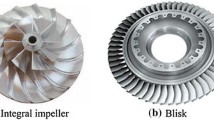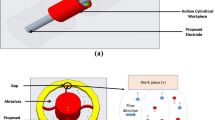Abstract
The blade surface roughness of blisk is of significance to performance of aero-engine on the aspects of thrust weight ratio and service life, etc. However, it is difficult to achieve uniform surface finish because of the strong geometry interferences arising from the complex structures, through the processes of manual finishing, belt grinding, and CNC polishing. In this paper, abrasive flow machining (AFM) process is adopted to polish blade surfaces of blisk with the aim to acquire qualified uniform surface finish, by virtue of AFM’s excellent machining flexibility for parts with structures difficult to machine. Researches on surface finishing are taken for the proposed experimental prototype blisk with straight blades, through the approaches of both experiments and numerical simulations, where abrasive media with different mesh sizes and mass fractions are used. Experimental results show that surface roughness values near regions of leading/trailing edges are higher than those in regions of blades’ center, although surface roughness of the whole blades is improved obviously after AFM process. And, results from numerical simulations indicate that there exist irregular flows of abrasive media and high-pressure gradients near the leading/trailing edges, which provides reasonable explanations why uneven surface finish of blades is not achieved. Based on these analyses, a new fixture with guild blocks is proposed and proper fixture parameters are set to efficiently regulate the abrasive media flows near leading/trailing edges, and the validation experiments show that surface finish uniformity of blades is achieved with this apparatus. The conclusion could be drawn from the studies of this paper that uniform surface finish for blisk is achievable through properly designed AFM fixtures.
Similar content being viewed by others
References
Herrmann P (1999) The EJ200-engine development and full certification for production release with Eurofighter EF2000. 35th AIAA / ASME / SAE / ASEE Joint Propulsion Conference, Los Angeles, CA:99–2661
Shi YY, Duan JH, Zhang JF, Dong T (2012) Blisk disc manufacturing process technology. Aeronaut Manuf Technol 3:26–31
Bußmann M, Kraus J, Bayer E (2005) An integrated cost-effective approach to blisk manufacturing. Proceedings of 17th symposium on air breathing engines
Xiao G, Huang Y (2015) Equivalent self-adaptive belt grinding for the real-R edge of an aero-engine precision-forged blade. Int J Adv Manuf Technol. doi:10.1007/s00170-015-7680-3
Bons JP (2010) A review of surface roughness effects in gas turbines. J Turbomach 132(2):1–16
Esfe HB, Kermani MJ, Avval MS (2015) Effects of surface roughness on deviation angle and performance losses in wet steam turbines. Appl Therm Eng 90:158–173
Abuaf N, Bunker RS, Lee CP (1998) Effects of surface roughness on heat transfer and aerodynamic performance of turbine airfoils. J Turbomach 120(3):522–529
Liu WW, Zhang DH, Shi YY, Ren JX, Wang WH (2004) Study on net-shape NC machining technology of thin-blade of aeroengine. Mech Sci Technol 23(3):329–331
Uhlmann E, Dethlffs A, Eulitz A (2014) Investigation of material removal and surface topography formation in vibratory finishing. Procedia CIRP 14:25–30
Feldmann G, Wong CC, Wei W, Haubold T (2014) Application of vibropeening on aero-engine component. Procedia CIRP 13:423–428
Zhao PB, Shi YY (2013) Composite adaptive control of belt polishing force for aero-engine blade. Chin J Mech Eng 26(5):988–996
Huang H, Gong ZM, Chen XQ, Zhou L (2002) Robotic grinding and polishing for turbine-vane overhaul. J Mater Process Technol 127(2):140–145
Duan JH, Shi YY, Li XB, Zhang JF (2011) Adaptive polishing for blisk by flexible grinding head. Acta Aeronaut ET Astronaut Sin 32(5):934–940
Guo YZ (1993) Applications of abrasive flow machining in aeroengine manufacturing. Aeronaut Manuf Technol 5:28–32
Xu JH, Zhang XY (1993) Applications of abrasive medium in polishing process. J Mater Eng 1:28–29
Jain VK, Adsul SG (2000) Experimental investigations into abrasive flow machining (AFM). Int J Mach Tool Manuf 40(7):1003–1021
Gorana VK, Jain VK, Lal GK (2004) Experimental investigation into cutting forces and active grain density during abrasive flow machining. Int J Mach Tool Manuf 44(2):201–211
Gorana VK, Jain VK, Lal GK (2006) Forces prediction during material deformation in abrasive flow machining. Wear 260(1):128–139
Gorana VK, Jain VK, Lal GK (2006) Prediction of surface roughness during abrasive flow machining. Int J Adv Manuf Technol 31(3–4):258–267
Kar KK, Ravikumar NL, Tailor PB, Ramkumar J, Sathiyamoorthy D (2009) Preferential media for abrasive flow machining. J Manuf Sci Eng 131(1):011009.01–011009.11
Kar KK, Ravikumar NL, Tailor PB, Ramkumar J, Sathiyamoorthy D (2009) Performance evaluation and rheological characterization of newly developed butyl rubber based media for abrasive flow machining process. J Mater Process Technol 209(4):2212–2221
Zhao PF (2011) Numerical simulation research of abrasive flow machining based on the finite element method. Dissertation, Taiyuan University of Technology
Sankar MR, Jain VK, Ramkumar J (2010) Rotational abrasive flow finishing (R-AFF) process and its effects on finished surface topography. Int J Mach Tool Manuf 50(7):637–650
Das M, Jain VK, Ghoshdastidar PS (2008) Fluid flow analysis of magnetorheological abrasive flow finishing (MRAFF) process. Int J Mach Tool Manuf 48(3):415–426
Sankar MR, Mondal S, Ramkumar J, Jain VK (2009) Experimental investigations and modeling of drill bit-guided abrasive flow finishing (DBG-AFF) process. Int J Adv Manuf Technol 42(7–8):678–688
Wan S, Ang YJ, Sato T, Lim GC (2014) Process modeling and CFD simulation of two-way abrasive flow machining. Int J Adv Manuf Technol 71(5–8):1077–1086
Venkatesh G, Sharma AK, Kumar P (2015) On ultrasonic assisted abrasive flow finishing of bevel gears. Int J Mach Tool Manuf 89:29–38
Chen KY, Cheng KC (2014) A study of helical passageways applied to polygon holes in abrasive flow machining. Int J Adv Manuf Technol 74(5–8):781–790
Wu MY, Gao H (2015) Experimental study on large size bearing ring raceways’ precision polishing with abrasive flowing machine (AFM) method. Int J Adv Manuf Technol. doi:10.1007/s00170-015-7706-x
Chen YK, Zhang X (2014) CFD-RANS model validation of turbulent flow: a case study on MAAT airship. Modelling, Identification & Control (ICMIC), 2014 Proceedings of the 6th International Conference on IEEE:254–258
Prieler R, Demuth M, Spoljaric D, Hochenauer C (2015) Numerical investigation of the steady flamelet approach under different combustion environments. Fuel 140:731–743
Author information
Authors and Affiliations
Corresponding author
Rights and permissions
About this article
Cite this article
Fu, Y., Wang, X., Gao, H. et al. Blade surface uniformity of blisk finished by abrasive flow machining. Int J Adv Manuf Technol 84, 1725–1735 (2016). https://doi.org/10.1007/s00170-015-8270-0
Received:
Accepted:
Published:
Issue Date:
DOI: https://doi.org/10.1007/s00170-015-8270-0




